Queensland |
||||||||||||||||||||||||||||||||||||||||||||||||||||||||||
 |
 |
|||||||||||||||||||||||||||||||||||||||||||||||||||||||||
Crocheted dress with raglan, lace pattern and short sleeves, worked top down. Sizes S - XXXL. The piece is worked in DROPS Safran.
DROPS 186-12 |
||||||||||||||||||||||||||||||||||||||||||||||||||||||||||
|
INFORMATION FOR THE PATTERN: CROCHET INFO: On beginning of each round with treble crochets replace first treble crochet with 3 chain stitches. The round finishes with 1 slip stitch in the 3rd chain stitch at the beginning of the round. INCREASE/DECREASE TIP (evenly spaced): To work out how to increase/decrease evenly, count the total number of stitches on the round (e.g. 114 stitches) and divide by the number of increases/decreases to be made (e.g. 29) = 3.9. In this example, increase in approx. every 4th stitch – read INCREASE TIP. When decreasing, crochet every 3rd and 4th stitch together – read DECREASE TIP. INCREASE TIP: Increase 1 treble crochet by working 2 treble crochets in the same stitch. DECREASE TIP: Decrease 1 treble crochet by working the next 2 treble crochets together as follows: Work 1 treble crochet, but wait with the last yarn over and pull through (= 2 loops on hook), work the next treble crochet, but when working the last pull through, pull the strand through all 3 loops on the hook. PATTERN: See diagrams A.1 to A.5. ---------------------------------------------------------- DRESS: The piece is worked in the round, top down. NECK: Work 114-118-124-128-132-136 slightly loose chain stitches with hook size 3.5 mm and Safran and form them into a ring with 1 slip stitch in the first chain stitch. ROUND 1: Work 2 chain stitches (equivalent to 1 half treble crochet), then work 1 half treble crochet in each chain stitch to end of round, finish the round with 1 slip stitch in the 2nd chain stitch at the beginning of the round = 114-118-124-128-132-136 half treble crochets. ROUND 2: Work 3 chain stitches (equivalent to 1 half treble crochet + 1 chain stitch), skip 1 half treble crochet, * work 1 half treble crochet in the next half treble crochet, 1 chain stitch, skip 1 half treble crochet *, work from *-* to end of round and finish with 1 slip stitch in the 2nd chain at the beginning of the round = 114-118-124-128-132-136 stitches on round. ROUND 3: Work 3 chain stitches (equivalent to 1 treble crochet), then work 1 treble crochet in each half treble crochet and 1 treble crochet around each chain stitch – AT THE SAME TIME increase 29-25-30-26-33-29 treble crochets evenly on round – read INCREASE/DECREASE TIP and INCREASE TIP = 143-143-154-154-165-165 treble crochets. Finish the round with 1 slip stitch in the 3rd chain stitch at the beginning of the round. Read CROCHET INFO and work A.1 in the round (= 13-13-14-14-15-15 repeats of 11 stitches). On the last round in A.1 you will, for the most part, work 15 treble crochets in each repeat, but in 5-5-6-10-7-11 repeats evenly spaced on the round, increase this to 16 treble crochets so that the total is 200-200-216-220-232-236 treble crochets on the round. The piece now measures approx. 7 cm from the cast-on edge. Now work yoke as described below. REMEMBER THE CROCHET TENSION! YOKE: Work 1 round of treble crochets with 1 treble crochet in each treble crochet. Then insert 4 marker threads in the piece as follows (without working the stitches): Count 34-34-38-39-42-43 treble crochets (= ½ back piece), insert 1 marker thread in the next treble crochet, count 30 treble crochets (= sleeve), insert 1 marker thread in the next treble crochet, count 68-68-76-78-84-86 treble crochets (= front piece), insert 1 marker thread in the next treble crochet, count 30 treble crochets (= sleeve), insert 1 marker thread in the next treble crochet. There are 34-34-38-39-42-43 treble crochets left on the round after the last treble crochet with marker thread. Continue working treble crochets in the round with 1 treble crochet in each treble crochet - AT THE SAME TIME increase to raglan at each marker thread as follows: ROUND 1: Work 1 treble crochet + 2 chain stitches + 1 treble crochet in each treble crochet with a marker thread (= 4 treble crochets increased on the round) = 204-204-220-224-236-240 treble crochets on the round. ROUND 2: Around each chain-space with 2 chain stitches work 1 treble crochet + 2 chain stitches + 1 treble crochet (= 8 treble crochets increased on round) = 212-212-228-232-244-248 treble crochets on round. Repeat round 2 until you have worked a total of 9-13-15-18-20-23 rounds with increases (including the increases in round 1) = 268-300-332-360-388-416 treble crochets on the round. On the next round work 1 treble crochet in each treble crochet, but around each chain-space with 2 chain stitches work 2 treble crochets (= 8 treble crochets increased on the round) = 276-308-340-368-396-424 treble crochets on the round. Continue to work treble crochets without increases until the piece measures 19-21-23-25-27-29 cm from the cast-on edge mid front. The next round is worked as follows: Work 40-44-48-53-59-65 treble crochets (including the 3 chain stitches at beginning of round = ½ back piece), work 8-8-10-10-12-14 slightly loose chain stitches, skip 58-66-74-78-80-82 treble crochets (= sleeve), work 80-88-96-106-118-130 treble crochets (= front piece), work 8-8-10-10-12-14 slightly loose chain stitches, skip 58-66-74-78-80-82 treble crochets (= sleeve) and work the last 40-44-48-53-59-65 treble crochets on the round (= ½ back piece). Cut the strand. Body and sleeves are finished separately. THE PIECE IS NOW MEASURED FROM HERE! BODY: Insert 1 marker in the middle of the 8-8-10-10-12-14 chain stitches under the sleeve on the one side of the piece and start the round here. Work 1 double crochet in the first chain stitch, 3 chain stitches (equivalent to 1 treble crochet), then work 1 treble crochet in each chain stitch and 1 treble crochet in each treble crochet to end of round = 176-192-212-232-260-288 treble crochets. Continue in the round with treble crochets. When the piece measures 2 cm from the separation, decrease 8-8-8-10-10-10 treble crochets evenly on round = 168-184-204-222-250-278 treble crochets – read INCREASE/DECREASE TIP. Repeat the decrease when the piece measures 6 cm from the separation = 160-176-196-212-240-268 treble crochets. When the piece measures 12 cm from the separation, increase 12-12-12-14-14-14 treble crochets evenly on round = 172-188-208-226-254-282 treble crochets. When the piece measures 18 cm from the separation, increase 12-12-12-14-14-14 treble crochets evenly on round = 184-200-220-240-268-296 treble crochets. When the piece measures 26 cm from the separation, increase 14 treble crochets evenly on round in all sizes = 198-214-234-254-282-310 treble crochets. When the piece measures 34 cm from the separation, increase 14 treble crochets evenly on round in all sizes = 212-228-248-268-296-324 treble crochets. When the piece measures 40-41-42-43-44-45 cm from the separation, (the piece now measures approx. 62-65-68-71-74-77 cm from the shoulder) increase 40-48-40-44-40-48 treble crochets evenly on round = 252-276-288-312-336-372 treble crochets. Work A.2 in the round (= 21-23-24-26-28-31 repeats of 12 stitches). AT THE SAME TIME on the last round in A.2 increase 52-60-64-72-64-60 treble crochets evenly on round = 304-336-352-384-400-432 treble crochets. Work A.3 in the round (= 19-21-22-24-25-27 repeats of 16 stitches). When A.3 has been completed, there are 475-525-550-600-625-675 treble crochets on the round. Now work A.X as shown in A.2 (= 2 rounds). AT THE SAME TIME on the last round increase 30-28-39-25-36-34 treble crochets evenly on round = 505-553-589-625-661-709 treble crochets. The next round is worked as follows: A.4A (= 6 stitches), work A.4B over the next 492-540-576-612-648-696 treble crochets (= 41-45-48-51-54-58 repeats of 12 stitches), finish with A.4C (= 7 stitches). When A.4 has been completed, cut and fasten the strand. The dress measures approx. 92-95-98-101-104-107 cm from the shoulder down. SLEEVE: Insert 1 marker in the middle of the 8-8-10-10-12-14 chain stitches under the sleeve on the one side of the piece and start the round here. Work 1 double crochet in the first chain stitch, 3 chain stitches (equivalent to 1 treble crochet), then work 1 treble crochet in each chain stitch and 1 treble crochet in each treble crochet to end of round = 66-74-84-88-92-96 treble crochets. Work 1 round of treble crochets where you decrease 6-2-12-4-8-0 treble crochets evenly on round = 60-72-72-84-84-96 treble crochets. Work A.5 in the round (= 5-6-6-7-7-8 repeats of 12 stitches). When there are 3 rounds left in A.5 change to hook size 3 mm. Finish working A.5, cut and fasten the strand. The sleeve measures approx. 8 cm from the separation. Work the other sleeve in the same way. |
||||||||||||||||||||||||||||||||||||||||||||||||||||||||||
Diagram explanations |
||||||||||||||||||||||||||||||||||||||||||||||||||||||||||
|
||||||||||||||||||||||||||||||||||||||||||||||||||||||||||
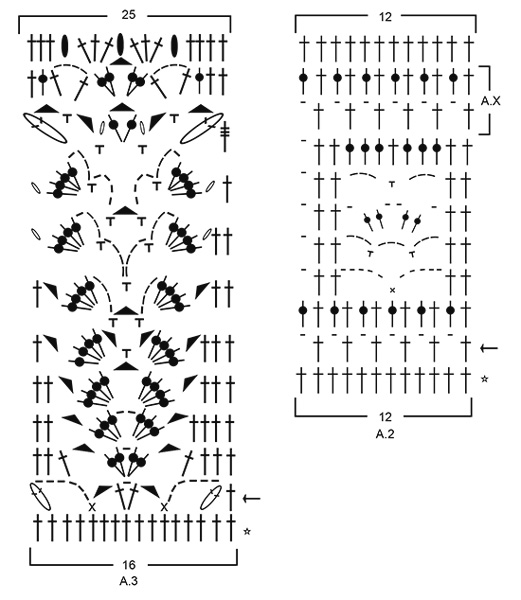
|
||||||||||||||||||||||||||||||||||||||||||||||||||||||||||
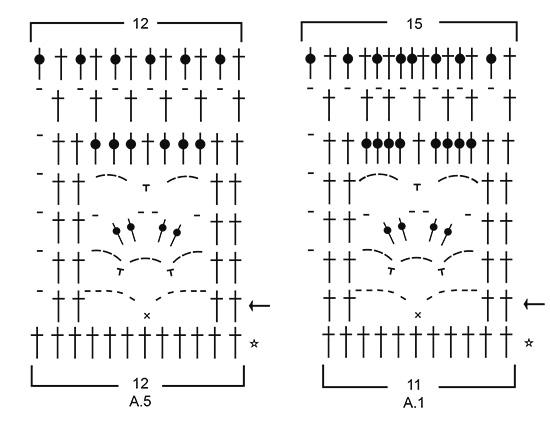
|
||||||||||||||||||||||||||||||||||||||||||||||||||||||||||

|
||||||||||||||||||||||||||||||||||||||||||||||||||||||||||
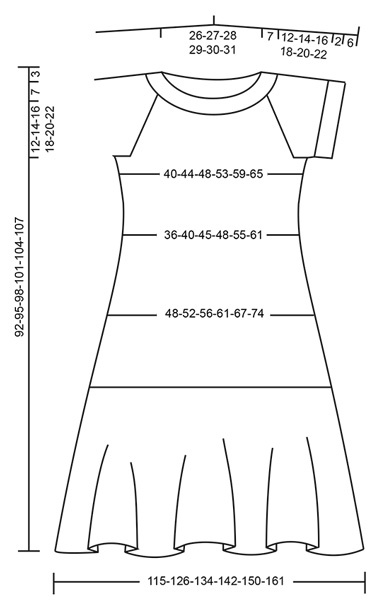
|
||||||||||||||||||||||||||||||||||||||||||||||||||||||||||
|
Have you made this or any other of our designs? Tag your pictures in social media with #dropsdesign so we can see them! Do you need help with this pattern?You'll find tutorial videos, a Comments/Questions area and more by visiting the pattern on garnstudio.com. © 1982-2024 DROPS Design A/S. We reserve all rights. This document, including all its sub-sections, has copyrights. Read more about what you can do with our patterns at the bottom of each pattern on our site. |
||||||||||||||||||||||||||||||||||||||||||||||||||||||||||

































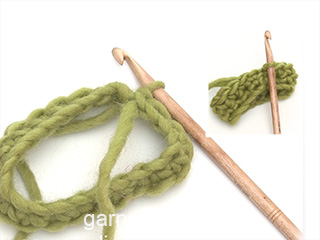
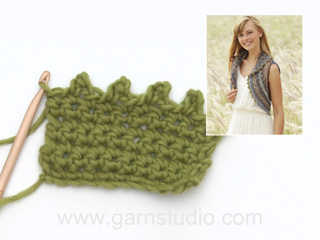























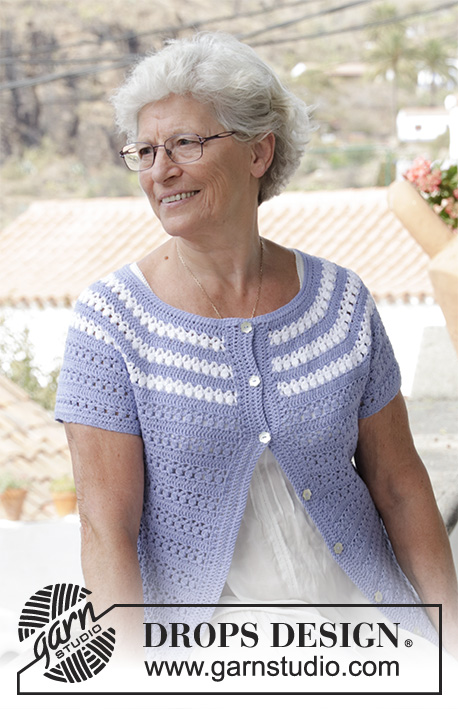
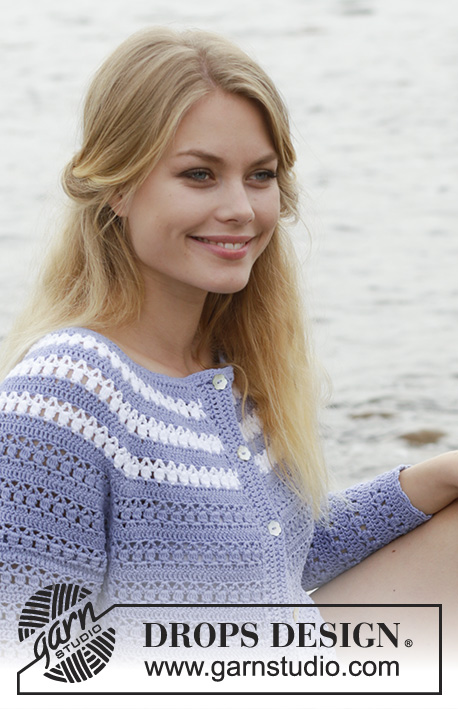






Comments / Questions (60)
Sonia wrote:
I'm stacked on Diagram A.3 I done up to row 7 on the diagram, but the way the stitches are illustrated can't understand how to do this row 8 do I stitch over the 4 dc from the previous row or do I skip them? please help. Thanks
05.08.2018 - 23:44DROPS Design answered:
Dear Sonia, on row 8 work: *1 dc, 1 ch, 4 dc around the 4-ch-space (= skip the 4 dc from previous round as before), then 4 ch, 1 sc around same ch-space, 4 ch, 1 sc around next ch-space, 3 ch, 1 sc around next ch-space, 4 ch, 1 sc around next ch-space, 4 ch, 4 dc around same ch-space, 1 ch*, repeat from *-*. Happy crocheting!
06.08.2018 - 09:54Lurer litt på str deres. I denne oppskriften går det fra S-XXXL. Str XL måles til 53cm over brystet. I oppskriften Cretan Summer som går fra XS-XXL måles str L 52cm over brystet. I normale klær bruker jeg S/M, men i denne oppskriften må jeg ha XL og i Cretan Summer må jeg ha L fordi M var alt for trang under ermet. Har dere noen form for logikk på str deres, eller er det litt hips som hap?
16.07.2018 - 08:53DROPS Design answered:
Hei Line. Størrelsenes mål avhenger av for eksempel plaggets form og bruksområde: en genser/jakke skal gjerne brukes utenpå andre plagg, mens dette er sjeldent for en kjole – det kan forklare hvorfor Cretan summer er større i størrelsen enn Queensland. Noen plagg skal også være løse og ledige, mens andre skal være tettsittende. Det er derfor viktig at du sjekker målskissen før du bestemmer hvilke størrelse som blir best. Du kan selvfølgelig også tilpasse ved å strikke en størrelse kortere/lengere slik at den passer deg bedre (vær da obs på at garnmengden blir påvirket). God fornøyelse
25.07.2018 - 14:50What does it mean to "Increase to raglan" I'm just starting the Yoke part, and have never heard that term before.
22.06.2018 - 02:18DROPS Design answered:
Dear Deanna, you will find here a video showing an example of increase for a raglan to shape a yoke worked top down. Happy crocheting!
22.06.2018 - 08:18Just a question or two. 1. What part is the "Yolk" it's a term I've never heard before, and I'm rather new to crocheting anything other than squares or rectangles. 2. Am I supposed to crochet two parts for the body and attach them or is it all one part?
20.06.2018 - 08:36DROPS Design answered:
Dear Deanna, see here what a yoke is. The dress is worked in the round from top down starting at neck, you will then work yoke (= increase for shoulder width), then divide piece for body and sleeves, work body (= bottom of dress from armhole to bottom edge) and then work sleeves separately. Happy crocheting!
20.06.2018 - 08:44Sonia wrote:
Hola! Hay que dividir el vestido en 4 partes 34-30-68-30-34 esto da 196 dc, pero después de terminar la ultima carrera del motivo A1 con los aumentos dice 200 dc esto no concuerda con el total de puntos altos? Termine la 6a corrida con 182 dc (pa) y ahora cuantos aumentos debo hacer en la 7a corrida de A1?
13.06.2018 - 19:39DROPS Design answered:
Hola Sonia. En tus cálculos has olvidado sumar los 4 puntos con marcapuntos que dividen la labor en 4 partes ( 196 + 4 = 200 puntos) En cuanto a la 2ª parte de la pregunta: Todos los aumentos y las disminuciones están explicados en el patrón y en los diagramas. No tienes que hacer ningun aumento más fuera del patrón.
23.06.2018 - 20:49Miss M wrote:
I cannot crochet this because it is in UK or Ireland abbreviations. It doesn't help that the needle size has a big E after it. I need help converting it to American words.
03.06.2018 - 20:36DROPS Design answered:
Dear Miss M, you can switch to American translation - see language menu under the photo, you can choose English (UK/cm) for Brittish version or English (US/in) for American. Happy crocheting!
03.06.2018 - 21:18Witam serdecznie, Chcialabym zrobic te sukienke , ale troche dluzsza. W ktorym miejscu najlepiej jest dorobic kilka centymetrow? Z góry dziekuje I pozdrawiam.
21.05.2018 - 08:18DROPS Design answered:
Witaj Grażyno! Sukienka jest wykonywana z góry na dół, na twoim miejscu wykonywałabym ją zgodnie ze wzorem do końca, a ewentualnie powtórzyłabym jakiś/jakieś ażurowe motywy na dole sukienki. Koniecznie zamieść zdjęcie gotowej sukienki na drops workshop na facebooku. Powodzenia!
21.05.2018 - 14:13Buongiorno, sto utilizzando questo modello adattandolo per farne una maglia, utilizzando un diverso filato lavorandolo a mezza maglia alta. Mi succede una cosa strana nel punto di giunzione del lavoro in tondo: il punto mi si sposta a spirale verso dx, spostando il riferimento del centro dietro. Perché? Che errore commetto? Grazie per l'attenzione.
05.05.2018 - 12:03LIZETTE MARSH wrote:
Hi there - just need to find out whether this pattern will work in a DK cotton yarn - please advise . SInce we are in South Africa and wont be able to purchase the yarn
28.04.2018 - 22:03DROPS Design answered:
Dear Mrs Marsh, this pattern is worked with DROPS Safran, ie a yarn group A = sport /5ply (read more here. You will find here a list of DROPS Stores shipping worldwide, contact them individually for any further informations. Happy crocheting!
30.04.2018 - 10:09Hi I am also struggling with the yoke increase as 1 dc at each marker is only 4 dc more , IE at the marker I am doing a dc then 2 chains then a dc therefore not really an increase should it be 2 dc two chains 2 dc ? as this would then leave the space you can see on the picture . near sleeves .
17.04.2018 - 09:17DROPS Design answered:
Dear Tracy, thanks for your feedback, there is now a correction at the end of neck (number of repeats where you increase) and at the beg of yoke. Correction is already available in UK-English, will come soon in US-English. Happy crocheting!
27.04.2018 - 15:32